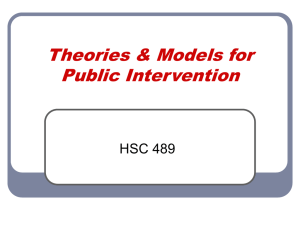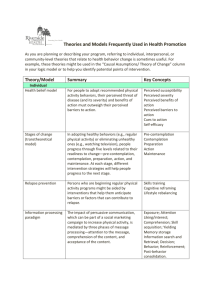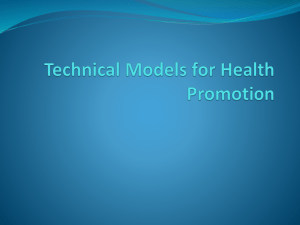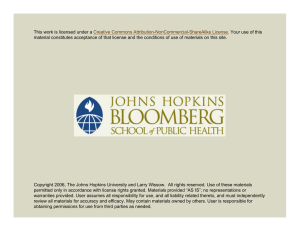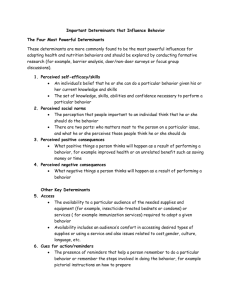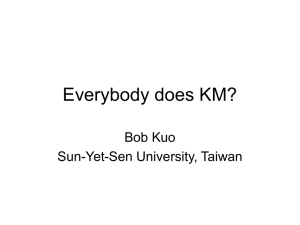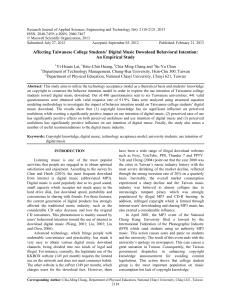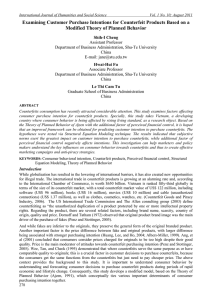presentation source - Mansfield University of Pennsylvania
advertisement
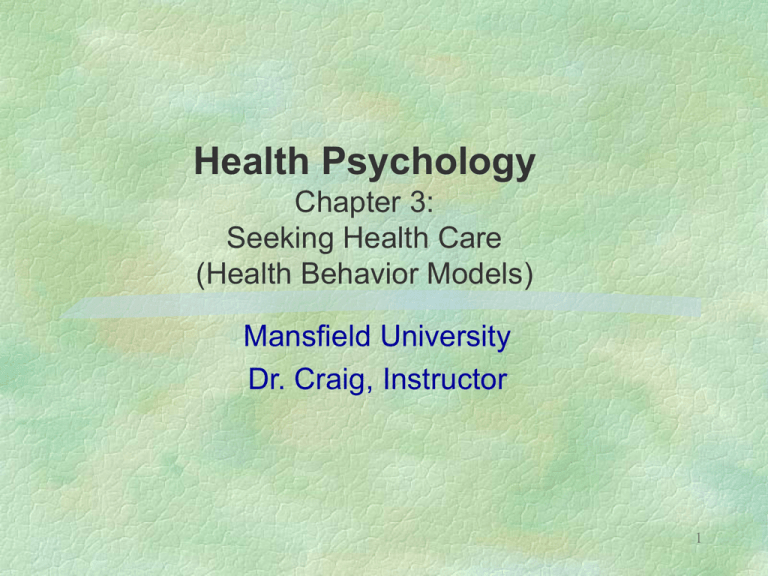
Health Psychology Chapter 3: Seeking Health Care (Health Behavior Models) Mansfield University Dr. Craig, Instructor 1 Understanding/Predicting/Treating Health Behvr. What measurable factors affect health behavior? Class thoughts Useful Theories generate research organize & explain observations (research & clinical) guide in predicting behavior (not in book) avenues for behavior change All models describe processes/or variables leading to INTENTIONAL changes toward healthy behaviors Health Belief Model (from Hochbaum) Theory of Reasoned Action (Azjen) Social-Cognitive Theory (Self-Regulation, Bandura) Transtheoretical Model (Prochaska & DiClemente) Well Studied Determinants 1. Characteristics of symptoms • painful? • Disabling? • Visible? 2. Perceived Cost/Benefit of seeking help • time, money, pain, 3. Perceived Severity of condition 4. Person’s Intention to Behave & Self-Efficacy 5. Readiness To Change 6. Social & Demographic Characteristics Perceived Susceptibility of Disease or Disability Rosenstock & Becker’s Health Belief Model (health seeking behavior) Perceived Severity of the Disease or Disability Perceived Benefits of Health Improving Behavior HEALTH SEEKING BEHAVIOR Perceived Barriers to Health Improving Behaviors Evidence for HBM Mixed evidence, but some impressive results Mammograpy • Champion- manipulated perceived susceptibility increased rate 4x • others have manipulated perceived barriers and benefits to increase attendance Also used in safe-sex, CV screening, AIDS testing, immunization efforts Large efforts will often manipulate multiple belief systems + other important variables to increase overall intention to behave Theory of Planned Behavior Attitude-thoughts, feeling, predisposition to act on a topic. One individual beliefs about behavior/condition Attitude Toward the Behavior RI Subjective Norm Perceived Behavioral Control Subjective Norm- attitude of the “social group” toward condition (e.g., what friends think, family says) Intention to Behave HEALTH BEHAVIOR Relative Importance- the relative influences of own attitude vs. what subjective norms “say” Perceived Behavior Control (self efficacy)- one belief in their capacity to exercise behavioral control over events that affect their lives. Event-specific Evidence for TPB An extension of the theory of reasoned action added the self-efficacy component Measures of intention and perceived behavioral control have been show to be particularly powerful predictors Stanford 5-city project predicted adolescent smoking Also predicted : health program attendance breast and testicular self examination dental flossing Building Self-Efficacy: Socio-Cognitive Models Self Efficacy- people’s beliefs about the capabilities to exercise control over events that affect their lives. A/K/A personal control, personal agency Tends to be situation specific It is continually modified by ongoing conditions It can be changed (increased) How can SE be changed? [class question] Self Efficacy: Social-Cognitive Model Performance/ Enacting a Behavior vicarious experience; seeing someone w/ similar skills act successfully + + + Sense of Personal Control makes increases likelihood of healthy behavior. It is affected by biological, socialcognitive & behavioral conditions Self-Efficacy Verbal persuasion or encouragement from trusted other Physiological Arousal - Goal (Intention) HEALTH BEHAVIOR Evidence & Info: Self-Efficacy Model Stanford 5 city project • those with most difficulty changing unhealthy behavior had the lowest efficacy Other studies • efficacy directly related to smoking cessation and goal attainment • exercise program adherence • stress management • eating/dietary behavior Many other models have added SE to greatly improved predictive power. Clear that SE is related to initiation of behavior, but not clear whether it is related to maintenance SE may be more related to behrs requiring “mastery of skills” (learned behaviors e.g condom use) than not (abstinence) Transtheoretical Model (TTM) Behavior Changes in Stages: • Precontemplation- no intention of changing bhvr, and may not think they have a problem at all • Contemplation- awareness of problem, some thought of doing something about it within 6 months • Preparation- specific behaviors and thoughts involved in planning to change behavior • Action- overt change in behavior made • Maintenance- sustain behaviors and prevent relapse Different Stages are affected by different factors, thus requiring different assistance to move to next stage Relapses part of the model-- to be expected Recognition of importance of decisional balance (pros and cons of maintaining risky behavior vs. healthy behavior) Stage Models: Transtheoretical Model Maintenance Behavior Action Preparation No Behavior, but varied Readiness to Change Contemplation Pre-Contemplation Measured by Decisional Balance survey (pros & cons)
